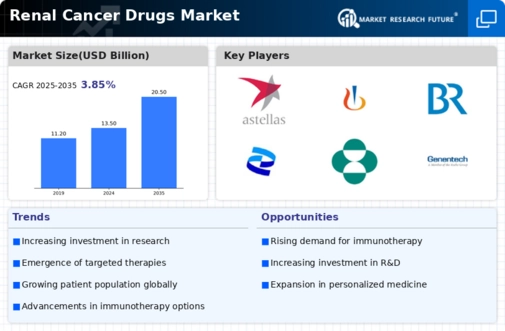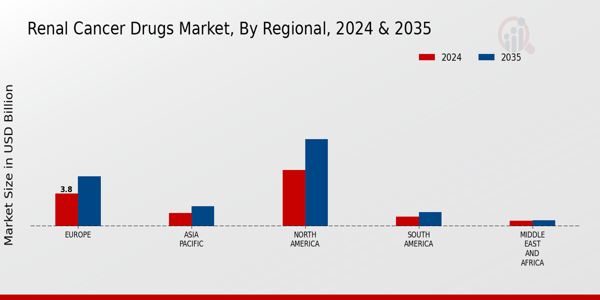Aging Population
The aging population is a critical driver of the Global Renal Cancer Drugs Market Industry. As individuals age, their risk of developing renal cancer increases, leading to a higher prevalence of the disease among older adults. According to demographic projections, the global population aged 65 and older is expected to reach 1.5 billion by 2050. This demographic shift is likely to result in a greater demand for renal cancer treatments, as older patients often require specialized care. The anticipated market growth reflects the need for effective therapies tailored to this aging demographic.
Market Growth Projections
The Global Renal Cancer Drugs Market Industry is poised for substantial growth, with projections indicating a market value of 13.5 USD Billion in 2024 and an increase to 20.5 USD Billion by 2035. This growth trajectory suggests a compound annual growth rate of 3.85% from 2025 to 2035, reflecting the increasing demand for renal cancer therapies. Factors contributing to this growth include advancements in treatment options, rising awareness of renal cancer, and an aging population. These dynamics underscore the potential for continued expansion in the renal cancer drug market.
Rising Incidence of Renal Cancer
The Global Renal Cancer Drugs Market Industry is witnessing growth driven by the increasing incidence of renal cancer worldwide. Data suggests that renal cancer cases are on the rise, with an estimated 431,000 new cases reported globally in 2020. This trend is expected to continue, leading to a greater demand for effective treatment options. As awareness of renal cancer increases, more patients are likely to seek medical attention, thereby expanding the market for renal cancer drugs. The projected market value of 13.5 USD Billion in 2024 reflects this growing need for innovative therapies and interventions.
Advancements in Targeted Therapies
Innovations in targeted therapies are significantly influencing the Global Renal Cancer Drugs Market Industry. These therapies, which focus on specific molecular targets associated with renal cancer, have shown promising results in clinical trials. For instance, drugs like nivolumab and cabozantinib have demonstrated improved survival rates in patients. The shift towards personalized medicine is likely to enhance treatment efficacy and patient outcomes. As the market evolves, the anticipated growth to 20.5 USD Billion by 2035 indicates a robust demand for these advanced therapeutic options, which are becoming increasingly integral to renal cancer management.
Regulatory Approvals and Market Access
Regulatory approvals play a pivotal role in shaping the Global Renal Cancer Drugs Market Industry. The timely approval of new drugs by regulatory bodies can significantly impact market dynamics. For instance, expedited review processes for promising therapies can lead to quicker access for patients in need. The increasing collaboration between pharmaceutical companies and regulatory agencies is likely to facilitate the introduction of innovative treatments. As the market evolves, the ability to navigate regulatory pathways effectively will be crucial for companies aiming to capture market share in this competitive landscape.
Increased Investment in Research and Development
The Global Renal Cancer Drugs Market Industry benefits from heightened investment in research and development. Pharmaceutical companies are allocating substantial resources to discover and develop novel therapies for renal cancer. This trend is evident in the increasing number of clinical trials aimed at evaluating new drug candidates. The commitment to innovation is expected to yield new treatment options, thereby expanding the market. The projected compound annual growth rate of 3.85% from 2025 to 2035 underscores the potential for growth driven by ongoing R&D efforts in the renal cancer sector.
























